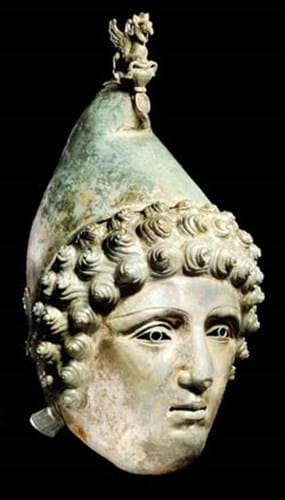
The 16in (41cm) high bronze parade helmet intended for ceremonial wear and now known as the Crosby Garrett helmet after the area of Cumbria where it was discovered, was found by a metal detectorist in May this year.
Although the main face section was intact, the helmet was in around 30 pieces when it was discovered. Christie's arranged to have it restored before it was offered at auction.
It was the highlight of Christie's South Kensington's October 7 antiquities sale, as in a few short minutes it eclipsed it's £200,000-300,000 estimate with six potential bidders: two in the room, three on the phone and one on the internet from California vying to secure it.
One of those contestants was the Tullie House Museum and Art Gallery in Carlisle who had been on a frantic attempt to raise the funds to acquire the helmet (including securing £1m from the National Heritage Memorial Fund) but they were unsuccessful.
London Antiquities dealer James Ede, who was bidding on behalf of the museum, went to £1.7m but two phone bidders were prepared to go even further.
Andrew Mackay of Tullie House who was at the sale, said they were "obviously very disappointed" not to have secured the bronze. "We did a fantastic finance-raising campaign," he said, praising a local public response that had seen "kids emptying their piggy banks".
Asked what the next step would be, Mr Mackay said it would be to make contact with the buyer. "The key thing is to try and find out who they are". Had the purchaser been based overseas there would have remained the possibility that the helmet could be the object of an export stop allowing the museum further time to raise the auction price.
But as it sold to a UK buyer this would not apply. A loan could be an option.
The museum is still keen to talk to the successful purchaser. "It would be fantastic to be able to display it in Cumbria," Mr Mackay told ATG last week.
The reason the helmet went to auction rather than becoming crown property (with the outcome that it would go direct to a Museum) is that the find is not classed as Treasure Trove.
While the helmet is a rare and impressive piece (one of only three comparable examples that have been discovered in Britain), the fact that it does not have a precious metal content over 10 per cent and was a solitary object, not part of a larger group find, means that under the Treasure Act it does not constitute treasure.
As such the finder, who had reported it under the Goverment's portable antiquities scheme and the landowner, are allowed to keep the piece rather than handing it over to the Crown and receiving its market value in compensation.
As a result of this case, the treasure law is expected to be reviewed.




